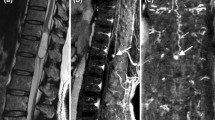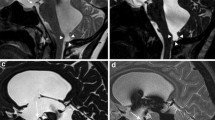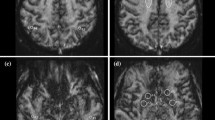Summary
To assess the clinical usefulness of partial flip angle (PFA) spin-echo (SE) brain imaging, a total of eighty patients were examined with both conventional double echo T2-weighted SE (2500/30, 80/90o/one excitation) and PFA double echo SE (1200/30, 70/45o/two excitations) on 2.0T system. Two comparative studies were performed: (1) in 65 patients PFA SE technique was compared with conventional SE without flow compensating gradients, and (2) in 15 patients the former was compared with the latter with flow compensating gradients. Imaging time was nearly identical in each sequence. In both studies we found that PFA T2-weighted SE images were almost identical to those obtained with the conventional SE technique in the contrast characteristics and the detection rate of the abnormalities (100%, 85/85 lesions), and more importantly, PFA SE revealed few flow artifacts in the brain stem, temporal lobes and basal ganglia which were frequently seen on conventional SE without flow compensating gradients. Additionally, PFA SE images demonstrated no suppression of CSF flow void in the aqueduct which was commonly seen on conventional SE with flow compensating gradients. In overall image quality, the PFA SE images, particularly the second echo images, were almost comparable with those of conventional SE with flow compensating gradients. A flip angle of 45o seems to be close to Ernst angle, the angle at which maximum signal occurs, for a given TR of 1200 msec for CSF and most of the abnormalities containing higher water content. In conclusion, PFA SE sequence (i. e. 1200/30, 70/45o/2) appears to be useful as a primary or an adjunctive technique in certain clinical circumstances, particularly in imaging of hydrocephalic patients for assessing aqueductal patency.
Similar content being viewed by others
References
Winkler ML, Ortendahl DA, Mills TC et al. (1988) Characteristics of partial flip angle and gradient reversal MR imaging. Radiology 166:17–26
Atlas SW, Mark AS, Grossman RI, Gomori JM (1988) Intracranial hemorrhage. Gradient-echo MR imaging at 1.5 T. Comparison with spin-echo imaging and clinical applications. Radiology 168:803–807
Winkler ML, Olson WL, Mills TC, Kaufman L (1987) Hemorrhagic and nonhemorrhagic brain lesions. Evaluation with 0.35-T fast MR imaging. Radiology 165:203–207
Drayer BP, Bird R, Hodak J, Flom RA (1987) Limited flip angle MR imaging. Nonhemorrhagic applications. Presented at the 25th Annual Meeting of the American Society of Neuroradiology, New York, May 10–15, 1987
Atlas SW, Grossman RI, Hackney DB et al. (1988) Calcified intracranial lesions. Detection with gradient-echo-acquisition rapid MRI. AJR 150:1383–1389
Atlas SW, Mark AS, Fram EK, Grossman RI (1988) Vascularintracranial lesions. Applications of gradient-echo MR imaging. Radiology 169:455–461
Atlas SW, Mark AS, Fram EK (1988) Aqueductal stenosis. Gradient-echo rapid MR imaging. Radiology 169:449–453
Haughton VM (1988) MR imaging of the spine. Radiology 166: 297–301
Koschorek F, Brinkmann G, Gremmel H (1987) Value of fast field echo imaging in recurrence of lumbar disk herniations. Radiology 165(P):251
Enzmann D, Rubin JB (1987) Evaluation of short repetition time, partial flip angle gradient recalled echo pulse sequence in cervical spine imaging. Radiology 165(P):251
Spritzer CE, McFall J (1989) Fast-scan imaging. In: Pomeranz SJ (ed) Craniospinal magnetic resonance imaging. Saunders, Philadelphia, pp 71–93
Bydder GM, Payne JA, Collins AG et al. (1987) Clinical use of rapid T2-weighted partial saturation sequences in MR imaging. J Comput Assist Tomogr 11:17–23
Grossman RI, Atlas SW, Hackney DB, Goldberg HI, Bilaniuk LT, Zimmerman RA (1987) Clinical utility of fast scanning techniques in the brain. Presented at the 6th Annual Meeting of Society of Magnetic Resonance in Medicine, New York, vol 1, p 311
Steinberg PM, Montanez J, Hueftle MG et al. (1987) Fast-gradient-echo short echo time imaging sequences in the evaluation of brain pathology. Radiology 165 (P):143
Runge VM, Osborne MA, Wolpert SM et al. (1987) The application of paraxial scanning to MRI of the CNS. Magn Reson Imag 5:87–95
Enzmann DR, Rubin JB, Wright A (1987) Use of cerebrospinal fluid gating to improve T2-weighted images. I. The spinal cord. Radiology 162:763–767
Enzmann DR, Rubin JB, O'Donohue J, Griffin C, Drace J, Wright A (1987) Use of cerebrospinal fluid gating to improve T2-weighted images. II. Temporal lobes, basal ganglia, and brain stem. Radiology 162:768–773
Haacke EM, Lenz GW (1987) Improving MR image quality in the presence of motion by using rephasing gradients. AJR 148: 1251–1258
Elster AD (1988) Motion artifact suppression technique (MAST) for cranial MR imaging. Superiority over cardiac gating for reducing phase-shift artifacts. AJNR 9:671–674
Quencer RM, Hinks RS, Pattany PH, Horen M, Post MJD (1988) Improved MR imaging of the brain by using compensating gradients to suppress motion-induced artifacts. AJR 151: 163–170
Mills TC, Ortendahl DA, Hylton NM (1986) Investigation of partial flip angle magnetic resonance imaging. IEEE Trans Nucl Sci NSA 33:496–500
Hackney DB, Lenkinski RE, Grossman RI et al. (1988) Initial experience with fast low-angle multiecho (FLAME) imaging of the central nervous system. J Comput Assist Tomogr 12:171–174
Tkach J, Haacke E (1987) Fast low angle spin echo (FATE) imaging. Fast MRI Topical Conference, Cleveland, Ohio, May 15–17, 1987
Mitchell DG, Vinitski S, Burk DL Jr, Levy D, Rifkin MD (1989) Variable-flip-angle spin-echo MR imaging of the pelvis. More versatile T2-weighted images. Radiology 171:525–529
Chisin R, Buxton RB, Ragozzino MW, Beaulieu PA, Fabian RL, Brady TJ (1989) Preliminary clinical results with low flip spinecho MR imaging of the head and neck. AJNR 10:719–724
Vinitski S, Fuka MZ, Boone JM et al. (1987) Contrast in variable flip angle fast MR imaging. IEEE Trans Nucl Sci NS 34:1110–1115
Vinitski S, Rifkin MD, Burk DL Jr, Mitchell DG (1987) Variable flip angle in fast spin-echo MR imaging. Radiology 165 (P):30
Axel L (1987) Small excitation flip angles and double 180° echoes for T2-weighted imaging with relatively short repetition times. Radiology 165(P):30
Ernst RR, Anderson WA (1966) Application of Fourier transform spectroscopy to magnetic resonance. Rev Sci Instr 37:93–102
Author information
Authors and Affiliations
Rights and permissions
About this article
Cite this article
Chang, K.H., Yi, J.G., Han, M.H. et al. Clinical utility of partial flip angle T2-weighted spin-echo imaging of the brain. Neuroradiology 32, 255–260 (1990). https://doi.org/10.1007/BF00593042
Received:
Issue Date:
DOI: https://doi.org/10.1007/BF00593042




